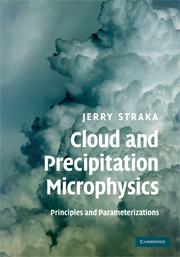Book contents
- Frontmatter
- Contents
- Preface
- 1 Introduction
- 2 Foundations of microphysical parameterizations
- 3 Cloud-droplet and cloud-ice crystal nucleation
- 4 Saturation adjustment
- 5 Vapor diffusion growth of liquid-water drops
- 6 Vapor diffusion growth of ice-water crystals and particles
- 7 Collection growth
- 8 Drop breakup
- 9 Autoconversions and conversions
- 10 Hail growth
- 11 Melting of ice
- 12 Microphysical parameterization problems and solutions
- 13 Model dynamics and finite differences
- Appendix
- References
- Index
2 - Foundations of microphysical parameterizations
Published online by Cambridge University Press: 23 November 2009
- Frontmatter
- Contents
- Preface
- 1 Introduction
- 2 Foundations of microphysical parameterizations
- 3 Cloud-droplet and cloud-ice crystal nucleation
- 4 Saturation adjustment
- 5 Vapor diffusion growth of liquid-water drops
- 6 Vapor diffusion growth of ice-water crystals and particles
- 7 Collection growth
- 8 Drop breakup
- 9 Autoconversions and conversions
- 10 Hail growth
- 11 Melting of ice
- 12 Microphysical parameterization problems and solutions
- 13 Model dynamics and finite differences
- Appendix
- References
- Index
Summary
Introduction
In this chapter the foundations of bulk, bin, and hybrid bulk–bin microphysical parameterizations will be presented with more significant focus on the first. Many aspects of these microphysical parameterizations require functional relationships to describe attributes of populations of hydrometeors so that specific equations for source and sink terms for different hydrometeor species or habits can be integrated for mixing ratio and concentration. In addition equations for the prognostication of reflectivity, mass weighted riming rate, elapsed time of riming, and mass weighted rime density are presented or derived. In addition a diagnostic equation for the shape parameter in the gamma distribution is developed. Then number density functions and moment generators are presented for bin microphysical parameterizations.
Background
This part of chapter two derives heavily from Flatau et al. (1989) in presenting some of the concepts of microphysical parameterization fundamentals. First the probability density function will be defined and explained. It is essential for parameterization work that the probability density function be integratable. We start with f(D) as the probability of number of particles of a certain size. It is preferred that the degrees of freedom of f(D) be restrained to a small number of observable quantities. If not, it may be possible or likely that certain parameterizations cannot be created. Finally it is necessary that f(D) needs to be readily normalizable.
The spectral number density function n(D) is the concentration of particles per unit size interval from D to ΔD.
Information
- Type
- Chapter
- Information
- Cloud and Precipitation MicrophysicsPrinciples and Parameterizations, pp. 19 - 58Publisher: Cambridge University PressPrint publication year: 2009
